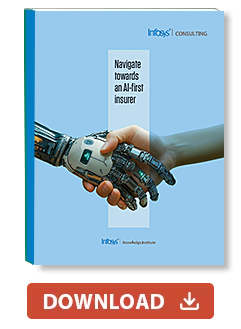Insights
- Insurers are rapidly adopting AI, but only a few achieve consistent success across use cases.
- AI leaders deploy more use cases, achieve better outcomes, and spend less per initiative.
- A robust AI strategy — anchored in vision, data, talent, and ethics — is key to unlocking scalable value.
- Operational hurdles like data quality, regulatory compliance, and workforce readiness need specific attention for a successful transformation.
- Executive leadership and continuous adaptation are critical to driving AI transformation in insurance.

Enterprise AI Readiness: Perspectives from New York Life Investments and Infosys
This insightful interview features Wei Wang, Director of AI and Data Science at New York Life Investment, and Sunil Senan, Global Head of Data, Analytics & AI at Infosys. Together, they explore how enterprises can move beyond the “ChatGPT moment” into responsible, scalable adoption of AI.
Introduction
The tide of AI is surging through the insurance industry, fundamentally reshaping its shores. Customers increasingly expect personalization and tailoring, proactive services, and seamless, intelligent interactions. They anticipate personalized product recommendations, instant claim approvals, and AI-powered advice for their health, property, investments, and other areas of life. Their interaction mode is shifting towards conversational AI, predictive communications, and truly intelligent self-service that anticipates their needs.
The value-add of AI in the 2020s goes far beyond automating business rules or simple data analysis that companies have used AI for already for years. 2020s will be defined by cognitive automation and intelligence with agency: Instead of executing predefined actions, the AI will work toward end goals with the available means. This shift allows for proactive, self-optimizing operations, where systems learn and adapt in real time, rather than merely being business rules engines.
AI adoption is fast and accelerating. In the USA, 76% of insurers have already implemented GenAI in one or more business functions. Even before this recent surge of AI, more than 70% of insurers in Europe and USA used pre-GenAI technologies in their processes, operations and strategic decisions. Furthermore, 92% of companies plan to increase their AI investments over the next 3 years. Unfortunately, in our survey across 228 insurers, only 28% of the deployed AI use cases achieve most or all of their objectives.
In our recent research, we identified that 9% of insurers are AI leaders. They have 54% more deployed and ongoing AI use cases than other insurers. They are 42% more likely to achieve the planned benefits than the other insurers. AI leaders also spend 31% less per use case. We foresee that the AI leaders will gain significant benefits with their first-mover advantage and can capitalize on their momentum.
How could an insurer uplift its AI capabilities and seize the AI future? Insurers need a robust AI strategy that, like a compass, will help them navigate the plethora of use cases and establish strong foundational elements across technology, data, and talent. A robust AI strategy is enabled by strong guidance on ethics and security as well as comprehensive people change management. This point of view offers a playbook to design and establish that AI strategy.
Key takeaways
Navigating the AI imperative in insurance
- Ride the AI wave
AI represents the most profound technological disruption in recent history, demanding strategic and decisive actions to secure future market leadership and competitive advantage. - Build strategic alignment
An effective AI strategy must directly align with core business objectives, ensuring every investment drives enterprise-wide transformation besides the measurable value. - Design a bold vision
Define audacious AI ambitions and rigorously prioritize high-impact use cases. This disciplined approach focuses investments and maximizes tangible business outcomes. - Invest in foundational capabilities
Success hinges on building a robust data and technology backbone, ensuring data integrity, scalable infrastructure, and efficient AI operations from the outset. - Centralize AI talent
Cultivate specialized capabilities and build an AI-powered center of excellence (COE) to lead the AI transformation. - Design AI responsibly
Embedding ethics, transparency, and robust security measures into AI systems from inception is crucial for compliance and sustained trust across stakeholder groups. - Adapt continuously
The dynamic AI landscape demands an agile approach, emphasizing rapid experimentation, swift iteration, and a holistic culture of continuous learning. - Confirm the realized value
Rigorously define and track the return on investment (ROI) for all AI initiatives. Accountability for tangible outcomes justifies the increasing investments and ensures scalable impact. - Address challenges proactively
Strategically anticipate and address common hurdles from data quality and regulatory complexity to adoption of AI by the workforce. - Champion the transformation from the top
Decisive executive leadership is vital to champion the AI vision, drive essential cultural change, and propel the organization toward an AI-driven future of unparalleled performance.

The AI-first insurer
Imagine interacting with an AI-first insurer that acts on your behalf for your benefit, simplifying decisions, and orchestrating your entire insurance journey from discovery to claims, with empathy, intelligence, and speed. We present a visionary customer journey that depicts health insurance. Its key elements can be generalized to other insurance as well.
1. Discover and tailor your coverage
You're vaguely aware of the need for health insurance but feel overwhelmed by the options. Suddenly, you see an online ad that isn't just generic; it highlights health concerns that resonate with how you have been feeling lately, even offering a quick quiz to assess your current health risk. Intrigued, you click. Instead of a daunting form, a friendly chat interface greets you, asking personalized and simple questions. It then suggests a few health insurance plans highlighting the features that resonate with you. Furthermore, the offer includes add-ons that interest you: perhaps preventive care coverage, mental health support, or gym membership discounts. Finally, it even includes how similar packages from other insurers compare to the proposed offer.
Key enabling capabilities

2. Onboarding and policy activation
You've selected a plan. The onboarding process is astonishingly quick and facilitated by the same chatbot. You upload a few documents it asks, and the AI instantly verifies them. Shortly, you receive digital confirmation of your policy, and a link to download the insurer’s mobile app. The app includes a personalized digital health assistant that proactively suggests health checkups and other activities that feel just right to be mindful but not too pushy.
Key enabling capabilities

3. Effortless healthcare
Later, by chance, you feel a bit off. The digital health assistant sends you a push notification to check for temperature and asks how you are feeling. Indeed, you confirm you have a fever and seek further medical advice. The digital health assistant helps you gauge the symptoms and recommends telehealth as the first consultation. You connect immediately with the general practitioner online who further recommends a specialist visit. The digital health assistant provides a list of paneled specialists in your area, checks their availability and provides options for booking an appointment. You select the suitable specialist and the time. Closer to the visit, you receive a reminder before the appointment suggesting travel routes to reach the clinic.
Key enabling capabilities

4. Streamlined claiming and rapid compensation
At the panel clinic, they have already received your insurance coverage and other information you wanted to share. You only pay for the co-payment, everything else is already deducted by the government (e.g. Medicare) and by the insurer. In non-panel clinic scenario, you could simply take a photo of the medical bill with your phone. The AI would extract the necessary information, prefill the claim, and alert you to any missing details. Once submitted, you receive a notification that it has been processed, and the funds are on their way to your bank account. You double-check the claim resolution with the AI assistant that explains the rationale in more detail.
Key enabling capabilities

Insurers’ success in AI transformation
Insurers are adopting AI quickly, but not always successfully.

Insurers have on average 10.4 AI use case categories deployed and live (Figure 1). The size of the insurer did not impact how many AI projects they have. What had an impact, was the self-proclaimed AI maturity. 9% of the insurers selected the highest level of AI maturity. We call them “AI leaders” in this point of view. These insurers responded that they are fully engaged in continuous AI training, education, and change management. They actively address and mitigate employee concerns about job impact, explainability, compliance, costs, and cultural barriers through transparent communication and involvement. Their employees are fully supported in understanding and adapting to AI, and their feedback actively informs AI deployment strategies. These AI leaders have faster AI adoption than their peers with 14.7 AI use case categories deployed per insurer. This means that AI leaders employ AI across their operations at a much larger spread than others.
Figure 1. AI leaders have 54% more AI use case categories live
Source: Infosys
The success of these projects is not automatic. We received information about 3,536 unique AI use case types in various stages of planning and implementation. 2,782 of these pursuits had been deployed to production. Sadly, only 28% of them had achieved most or all objectives. Additionally, 14% of the use cases were cancelled only after they had already deployed to production. AI leaders are 42% more likely to achieve most or all of the objectives for the use cases they deploy (Figure 2).
Figure 2. AI leaders are 42% more likely to achieve their objectives
Source: Infosys
AI leaders face similar difficulties implementing AI innovations compared to all other insurers (Figure 3). It is only slightly easier for the leaders to technically or operationally implement the AI innovations. AI is generally accepted by users regardless of the perceived AI maturity. Figure 4 depicts how the scoring parameters have been set for AI leaders and others across these three metrics.
Figure 3. All insurers have roughly the same difficulty to implement
Source: Infosys
Figure 4. Survey score parameters
Source: Infosys
Despite the similar difficulty to implement, AI leaders spend on average 32% less per AI use case (Figure 5). This is partially driven by benefits of scale: more projects mean faster learning. Based on our experience, the AI leaders have a robust AI strategy in place, and they have established a factory-like model to centrally govern AI strategy, models, data, ethics, security and change considerations.
Figure 5. AI leaders spend 32% less per use case type
Source: Infosys
To become an AI leader, insurers need to establish a robust AI strategy and successfully operationalize it. The next chapters highlight the structure and elements for the AI strategy, how to design and implement it, and finally how to avoid typical pitfalls in the journey toward AI leadership.
Use cases
Figure 6. Example of Optum Bank using microsegmentation for targeted campaign
Figure 7. Example of lemonade using intelligent automation in operations
Comprehensive AI strategy framework
AI strategy defines how insurers will gain value from AI investments
Figure 8. AI strategy framework
Source: Infosys
Insurers that succeed in AI investments have a robust AI strategy that guides them where to invest. We present a robust framework for AI strategy that captures the technology’s interconnected nature.
This framework provides five pivotal elements:
- A clear AI vision crystallizes business ambitions, aligning with corporate strategy and market dynamics.
- A structured use case selection identifies AI initiatives worth pursuing.
- A solid data and technology foundation builds essential capabilities.
- Thoughtful talent and organizational design creates the operational structures and develops the necessary competence.
- Continuous emphasis on ethics, security, and change ensures long-term viability and trust.
1. AI vision: The NORTH STAR
At the heart of the AI strategy lies the AI vision. It serves as the definitive North Star for all AI implementations, aligning directly with corporate strategy. This vision is shaped by evolving customer expectations, competitive dynamics, and market best practices. It provides a future-oriented target state, clear focus areas, and concrete goals. This vision should be communicated broadly to rally the employees, investors, customers, and other stakeholders for the transformation ahead.
2. AI use cases: Prioritized for impact
This layer translates the AI vision into tangible initiatives. It defines where to invest resources to generate the most significant business value. Prioritize rigorously, selecting AI use cases based on strategic fit, measurable business value, and organization's capability to execute. This disciplined approach means explicitly deciding which initiatives you will "secure" and "which you don't," ensuring every project contributes directly to your defined ambitions.
3. Data and technology foundation: The engine
A robust data and technology foundation is the engine powering all AI initiatives. This includes defining scalable data infrastructure, ensuring data quality and governance, and selecting the right AI tools and platforms. This foundation defines the common AI technology stack for all use cases. While it shares principles with existing data management, AI's unique demands for model selection and training impose specific requirements on data preparation and infrastructure. Critically, this foundation inherently considers ethical principles, data privacy, and bias prevention, which must be woven into its design from the outset.
4. Talent and organizational design: Structure for AI execution
AI demands specific talent and a well-governed integration with the rest of the organization. This layer defines the operational framework to execute the AI strategy. Design a structure that effectively pools AI expertise, demarcates accountability and responsibility with the other departments and functions, and fosters cross-functional collaboration. Consider centralized models like an AI COE to accelerate capability build. At a higher AI maturity level, federated models with embedded AI teams may become more beneficial. Consider how the teams manage and optimize the operational life cycle of AI models.
5. Ethics, security, and change: Guide every implementation
Ethics, security, and change management are fundamental enablers that guide every aspect of AI implementation, ensuring responsible, secure, and successful adoption.
Ethics: Establish clear guidelines for responsible AI development and deployment. Design for fairness, transparency, and accountability from the outset. Implement measures to detect and mitigate biases in AI algorithms. Protect data privacy, especially with sensitive customer information, and comply with evolving regulations.
Security: Adopt stringent measures to protect AI models, data, and outputs from unauthorized access and misuse. Your AI systems must be resilient to cyber threats and maintain data integrity. This also includes sensitive data protection and access management.
Change: AI adoption requires significant organizational transformation. A structured change management approach will ensure smooth transition and widespread adoption. Engage stakeholders: employees, customers, and regulators, early to build trust. Define how to best upskill employees in AI literacy and help them adapt to AI-enabled processes and workflows. Encourage a culture of experimentation and iterative implementation.
Figure 9. Function of AI COE
Figure 10. Selected use cases for health insurance
Source: Infosys
Figure 11. Use of generative AI in customer interactions
Figure 12. Use of generative AI in personalised packages
Crafting the AI strategy
Crafting a comprehensive AI strategy requires agility, foresight, and intelligent capability integration. This chapter delivers the playbook: A clear guide to formulating an AI strategy that aligns with corporate ambitions.
AI is not an end by itself, but a powerful means to achieve strategic objectives. Align the company’s AI strategy with its overarching vision and goals. This ensures every AI investment serves a higher purpose, focusing initiatives on critical action areas. This alignment secures executive support, ensures focus on the big picture, and eases justifying the funding. Use AI to powerfully enhance existing objectives, streamline core processes, aggressively unlock avenues for growth and explore new business models. We structure the AI strategy creation into four key steps (Figure 12).
Figure 13. Designing and implementing the AI strategy in four steps
Source: Infosys
1. Set bold AI ambitions
The AI ambitions must ignite action and accelerate innovation across the enterprise. Define clear, audacious aims aligned with the corporate strategy. For example: accelerate growth, disrupt the industry by redefining customer expectations, establish new benchmarks for operational efficiency, or become the most insight-driven enterprise. Make them audacious enough to serve as a long-term North Star, yet specific enough to rigorously prioritize AI use cases and guide strategic deployment. This prevents diffused efforts, ensuring every initiative contributes directly to your commanding goals.
2. Prioritize high-impact use cases
There are hundreds of AI use cases, many promising rapid returns. This abundance often breeds paralysis or diffuse efforts. AI strategy needs to cut through this complexity, focusing on what truly matters. Prioritize rigorously based on strategic fit, business value, capability to execute and, finally, portfolio balance. Apply first the filter of strategic fit to clear out the initiatives not aligning with the company’s goals. Then estimate the value of the AI use cases based on their impact using, for example, projected revenue, cost reduction, risk mitigation, or customer satisfaction uplift. Assess the feasibility to implement including technical complexity, data availability and quality, infrastructure readiness, and required talent. Build a balanced portfolio securing quick wins to demonstrate immediate value and fuel momentum, while investing in transformative projects for long-term strategic advantage. Each choice must carry clear, measurable success metrics.
3. Communicate the AI vision
Secure buy-in from all the company’s stakeholders: investors, partners, customers and employees. Help them understand the “why, what, and how” of the transformation ahead. Forge a transparent, engaging communication plan that resonates with each distinct audience. Especially the employees require attention. Proactively address job evolution, clearly articulating how AI will augment their capabilities, empower them, and enhance their value. Communication needs to build excitement through early wins, foster trust through clarity, and unify everyone behind your AI imperative. Strong leadership championing this vision is non-negotiable.
4. Experiment and adapt
The AI landscape shifts constantly; organizations must embrace adaptability. Make experimentation a core discipline: test and validate AI solutions rapidly. Ruthlessly eliminate initiatives failing to meet predefined targets or failing to demonstrate clear value. This 'fail fast' approach efficiently identifies effective AI applications for the company’s unique context, allowing swift resource reallocation. Establish an AI Center of Excellence to own the AI innovation funnel. This structure pools expertise, centralizes funding, and streamlines idea generation, rigorous prioritization, and rapid prototyping.

Overcoming strategic hurdles
Navigate the AI transformation
AI offers transformative potential, but realizing its value is not automatic. We have identified key challenges that may thwart success in AI. Proactive management of these strategic hurdles is paramount to unlock AI's full power and build competitive advantage.
1. Data integrity
The problem: Poor data poisons AI. Inconsistent, incomplete, or biased data inevitably leads to skewed insights, flawed risk assessments, pricing errors, unwarranted claim rejections, and costly claims leakage. This directly impacts profitability, erodes customer trust, and invites regulatory scrutiny. 40% of insurers consider data challenges to be the barrier to AI adoption.
The strategy: Elevate data integrity to a strategic imperative. Implement rigorous, enterprise-wide data governance from source to model. Build robust data pipelines to ensure continuous cleansing, validation, and quality control. Leverage AI itself for continuous data quality monitoring and automated remediation.
2. Ethical AI and regulatory compliance
The problem: AI operates with sensitive customer data. Untamed AI risks bias, privacy breaches, and regulatory fines, threatening your reputation and trust. In insurance, health data exacerbates ethical complexities: What is ethical for preventive care may be problematic for pricing. 36% of insurers consider regulatory hurdles to be a barrier to AI adoption.
The strategy: Design AI with ethics and compliance from inception. Establish clear opt-in/opt-out mechanisms for data usage. Build transparent, explainable AI models to demystify decisions. Include a remediation process in the design to revisit AI decisions as needed. Implement continuous audit mechanisms to evaluate model fairness and outcomes. View ethical AI as a critical differentiator and a core trust-building imperative, not merely a compliance burden. Proactively engage regulators to shape industry standards.
3. Operational scalability and integration
The problem: Scaling AI beyond pilot projects often hits formidable walls: legacy systems, fragmented data silos, and computational constraints. This limits AI's impact, slows enterprise-wide adoption, and inflates operational costs.
The strategy: Architect for scale from day one. Prioritize modular, cloud-native infrastructures. Optimize AI models for seamless integration with core insurance platforms, ensuring real-time decision-making. Implement a phased deployment approach with a clear roadmap for enterprise-wide scaling. Focus on maximizing return on investment by ensuring AI can deliver real-time impact across all functions, transforming operations and accelerating time-to-market for new capabilities.
4. Workforce transformation
The problem: AI fundamentally shifts roles and demands new skills. Workforce resistance, lack of AI literacy, and critical skill gaps hinder adoption and mute AI initiative effectiveness. 52% of insurers say that skills and resource constraints limit their AI adoption.
The strategy: Invest aggressively in AI literacy and targeted upskilling programs for all employees. Integrate AI training into every professional development pathway, directly aligning new capabilities with business goals. Foster a pervasive culture of human-AI collaboration where AI augments human capabilities, empowering your teams, not replacing them. Accelerate AI adoption with strategic partnerships who can provide the necessary resources, guidance, and support.
5. Value realization and ROI measurement
The problem: Many AI initiatives get trapped in "pilot purgatory" or scale slowly because they fail to demonstrate clear, attributable business value. Without robust mechanisms to quantify ROI, complex AI investments can consume significant resources without proving their strategic or financial impact, leading to executive skepticism and loss of future funding.
The strategy: Embed value realization into your AI strategy from inception. Before launching any AI initiative, establish key performance indicators (KPIs) and the initiative’s objectives and key results (OKRs) directly linked to AI's impact. Implement rigorous tracking and reporting systems to continuously measure these KPIs throughout the AI life cycle, from pilot to full enterprise deployment. Assign clear ownership for value realization to business leaders. Regularly communicate demonstrated ROI and strategic impact to all stakeholders. This disciplined approach ensures every AI investment is accountable, builds executive confidence, and secures sustained commitment.
Seizing the AI future
Secure AI success with strategic investment
The AI era is not merely another technological advancement; it represents a fundamental, irreversible shift in how businesses operate and deliver value. Just as the internet, e-commerce, and smartphones redefined industries, AI now compels leaders to act decisively, or risk strategic obsolescence.
The choice today is clear: To either lead this transformation or risk being left behind. Strategic investment in AI proves paramount to achieving unparalleled efficiency, forging deeper customer trust, enabling precise risk management, and unlocking entirely new business models for unprecedented growth.
For organizations that have already initiated AI programs, now is the time to refine and accelerate. Re-evaluating existing initiatives against a clear strategic vision becomes critical. For all executives, championing this journey with decisive leadership is imperative.
Source and further reading
- https://www.infosys.com/iki/research/infosys-global-insurance-journal.html
- https://www2.deloitte.com/us/en/insights/industry/financial-services/scaling-gen-ai-insurance.html
- https://www.cdp.center/post/artificial-intelligence-in-insurance-major-companies-case-studies-2025
- https://www.mckinsey.com/capabilities/mckinsey-digital/our-insights/superagency-in-the-workplace-empowering-people-to-unlock-ais-full-potential-at-work
- https://www.mckinsey.com/industries/financial-services/our-insights/scaling-gen-ai-in-banking-choosing-the-best-operating-model
- https://www.ibm.com/blog/artificial-intelligence-strategy/
- https://www.gartner.com/en/information-technology/topics/ai-strategy-for-business
- https://www2.deloitte.com/us/en/pages/technology/articles/effective-ai-strategy.html
- https://bernardmarr.com/how-to-develop-your-artificial-intelligence-ai-strategy-with-handy-template/
- https://hbr.org/2023/07/build-a-winning-ai-strategy-for-your-business
- https://www.munichre.com/us-life/en/perspectives/underwriting/Creating-an-AI-Strategy-from-the-Ground-Up.html
- https://www.pwc.com/gx/en/about/pwc-asia-pacific/asia-pacific-blogs/gen-ai-bridging-the-gap-between-intent-and-adoption.html
- https://www.mckinsey.com/capabilities/mckinsey-digital/our-insights/enterprise-technologys-next-chapter-four-gen-ai-shifts-that-will-reshape-business-technology
- https://www.ey.com/en_gr/insights/financial-services/how-artificial-intelligence-is-reshaping-the-financial-services-industry
- https://www.codebtech.com/how-ai-could-reshape-finance-in-2024/
- https://dxc.com/us/en/insights/perspectives/paper/ai-strategies-for-the-insurance-industry
- https://www.limit.com/blog/6-ai-strategies-that-set-leading-insurance-firms-apart/
- https://www.ey.com/en_us/insights/insurance/how-insurers-can-leverage-the-power-of-generative-ai
- https://www.lemonade.com/claims
- https://www.lemonade.com/investor-relations-bo/wp-content/uploads/2025/04/Q4-2024.pdf
- https://www.lemonade.com/blog/lemonades-claim-automation/
- https://www.devoteam.com/expert-view/innovation-in-insurance/
- https://aimagazine.com/articles/lemonade-sets-world-record-with-2-second-ai-insurance-claim
- https://www.wsj.com/articles/turns-out-ai-is-more-empathetic-than-allstates-insurance-reps-cf5f7c98
- https://www.tietoevry.com/en/blog/2023/04/pause-pivot-and-find-the-valuable-use-case-learnings-from-allstates-conversational-ai-journey/
- https://www.lemonade.com/investor-relations-bo/wp-content/uploads/2025/04/Q4-2024.pdf
- https://www.lemonade.com/blog/precision-underwriting/
- https://www.lemonade.com/investor-relations-bo/wp-content/uploads/2025/04/LMND-Shareholder-Letter-Q4-2024.pdf



















